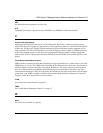
7000 Series L3 Managed Switch Reference Manual for Software v2.0
Glossary C-23
Spanning Tree Protocol (STP)
A protocol that finds the most efficient path between segments of a multi-looped, bridged network. STP
allows redundant switches and bridges to be used for network resilience, without the broadcast storms
associated with looping. If a switch or bridge falls, a new path to a redundant switch or bridge is opened.
SRAM
Static Random Access Memory.
STP
Spanning Tree Protocol. See “802.1D” on page 1 for more information.
stub area
OSPF area that carries a default route, intra-area routes, and interarea routes, but does not carry external
routes. Virtual links cannot be configured across a stub area, and they cannot contain an ASBR. Compare
with non-stub area. See also ASAM and OSPF. (Cisco Systems Inc.)
Subnet Mask
Combined with the IP address, the IP Subnet Mask allows a device to know which other addresses are local
to it, and which must be reached through a gateway or router.
Switch
A device that interconnects several LANs to form a single logical LAN that comprises of several LAN
segments. Switches are similar to bridges, in that they connect LANs of a different type; however they
connect more LANs than a bridge and are generally more sophisticated.
SX
See “SimpleX signaling” on page 22.
SYSAPI
See “Systems Application Programming Interface” on page 23.
Systems Application Programming Interface
SYSAPI is a module within the System Support software that provides system-wide routines for network
and mbuf support and provides the interface into the system registry.
T
TBI.
Ten Bit Interface.


















